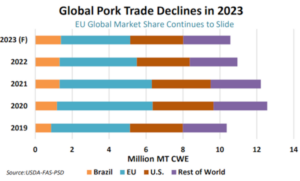Reduced exports from the EU, UK, Canada and Mexico will outweigh growth in Brazil, China and the US, leading to total export volumes to decline by 3% in 2023, according to the latest USDA figures.
Flattening global pork production volumes, at 114.33 million metric tonnes, is also predicted. This is driven by production declines in the EU, UK and Canada offsetting production gains in Vietnam, Russia, Brazil and China.
The USDA  forecast EU and Canadian pork exports to be down year on year by 10% and 4% respectively. High input costs and herd contraction have negatively impacted production volumes in these regions, limiting the availability of product. This has led to price rises, making the product less competitive on the global market.
forecast EU and Canadian pork exports to be down year on year by 10% and 4% respectively. High input costs and herd contraction have negatively impacted production volumes in these regions, limiting the availability of product. This has led to price rises, making the product less competitive on the global market.
However, for Mexico, the decline in exports is due to increased domestic consumption limiting supplies available. Total pork exports (excluding offal) are down for these regions year on year. The EU has exported 506k tonnes in the first two months of 2023, a decline of 17% year on year and Canada has exported 171k tonnes, falling 10% compared to last year. UK exports have totalled 26k tonnes for the year to date (Jan-Feb), down 31% year on year.
In contrast, exports from China are forecast to grow by 24,000 metric tonnes as border restrictions in Hong Kong and Japan are lifted, likely resulting in increased import demand from the hospitality and food service sectors. The US and Brazil also anticipate seeing increased volumes shipped to Southeast Asia as well as to South America. Increased production is forecast in both countries (US up 1% and Brazil up 2% year on year) contributing to greater product availability at competitive prices.




